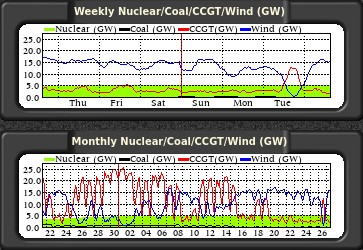There's a #storm currently blowing in the #NorthernBritain, which is right now contributing almost 70% of the nation's #ElectrictyDemand.
5 Likes
1 Comments
There's a #storm currently blowing in the #NorthernBritain, which is right now contributing almost 70% of the nation's #ElectrictyDemand.
It's very windy this evening but the good news is that it is providing nearly 60% of the country's #electricity demand right now. #FoosilFuels (all #Gas these days) is down to below 10%.
#Environment #RenewableEnergy #Renewables #SolarEnergy #WindEnergy
It's a nice #SunnyDay outside and it really feels like spring. The #bees are busy making use of the #flowers, while the flowers are busy making use of the bees.
The #UK #ElectricyDemand is currently 32 GW and of that, 25.2% is coming from #SolarEnergy, 17.1% is coming from #WindEnergy, 16.8% is coming from #NuclearEnergy and 9.9% is coming from #Biomass and only 7% is coming from #Gas. There is also a fair amount coming from continental Europe through the various interconnections.
https://www.gridwatch.templar.co.uk/
#Environment #Electricity #FossilFuels #GreenhouseGases Renewables #RenewableEnergy
Right now, less that 5.5% of the #UK's #ElectricityDemand is being provided by #Gas and nearly 46% by #WindEnergy and 13.4% by #SolarEnergy.
https://www.gridwatch.templar.co.uk/
#GreenhouseGases #Energy #Renewables #RenewableEnergy #FossilFuels
Right now, #FossilFuels are accounting for just 5.9% of the #UK's #Electricity generation. #WindEnergy is contributing 45.5%, #SolarEnergy 19.0% and #NuclearEnergy 13.9%. The rest comes from interconnects from continental #Europe and small amounts from #Hydropower and #Biomass. Some is also being exported to #Ireland.

Over the past ten days or so, #WindEnergy has provided a large fraction of the #UK's #Electricity demand, often above half of it. Even now, it is providing 47% and keeping #Gas down to single figure in percentage terms. There was a lull overnight but the new #storm, #Gerrit is currently the main source.
It’s an ill wind, as the saying begins, #StormCiaran has been generating lots of #RenewableEnergy. Even though it has calmed down a lot, 37% of #electricity demand is currently being met by #WindEnergy.
In the #UK currently, the #electricity demand is 30.5 GW. It is being met by 13.9% by #NuclearEnergy, 26.3% by #WindEnergy, 24.1% by #SolarEnergy and only 6.7% by #Gas. Energy is being imported from France (9.8%) and the Netherlands (3.5%) via interconnections. A small amount (1.5%) is being exported to Ireland.
https://www.gridwatch.templar.co.uk/
Single-bladed floating wind turbine. From a Dutch company called Touchwind.
"It's designed around a massive single-piece rotor, sitting on the end of a pole that's draped over a big barrel, with a large floating buoy hanging beneath it."
"This one huge double blade, says Touchwind, should cost around 30% as much to make as the triple-bladed arrangements on traditional turbines. It doesn't require any expensive active blade-pitch control systems, and where most standard turbines need to shut down in wind speeds above 25 or so m/sec (90 km/h / 56 mph), this one is rated for speeds as high as 70 m/sec (252 km/h / 157 mph). Less downtime equals more productive hours and more energy."
The reason for the lack of active blade-pitch control systems is the wind itself and the dangling buoy server to control the angle of the blade, so it always has the right exposure to the wind.
Single-bladed floating wind turbine promises half the cost, more power
Currently, less than 10% of the #UK #Electricity demand is being met by #gas, nearly 54% is being supplied by #WindEnergy and 10% by #SolarEnergy.
#SolarEnergy is currently providing over 32% of the #UK's electricity demand. #WindEnergy is down below 14% but together, they are providing nearly half of the electrical power requirement. #France is contributing over 10% and 2.6% from #Norway. About 3.6% is being exported to #Ireland via two interconnects.
http://www.gridwatch.templar.co.uk/
Right now, over 20% of the #UK's #electricity demand is being met by #SolarEnergy, less than 2% by #WindEnergy, around 12% by #NuclearEnergy and 40% by #Gas. Another nearly 20% is being imported from continental #Europe.
Right now, 22% of #UK #electricity demand is being met by #SolarEnergy and 21% by #WindEnergy. It’s not often that light beats wind as a power source here.
The Americans warned Germany, as did the Eastern Europeans. But Germany just continued buying more and more natural gas from Russia. The addiction stretches back several decades, and it is full of misjudgments and errors.#RussiasWarAgainstUkraine #VladimirPutin #Russia #FossilFuels #WindEnergy #EnergyandNaturalResources #GermanEnergyRevolution #NaturalGas #RenewableEnergy #Energy #Business
Decades of Addiction: The Anatomy of Germany's Reliance on Russian Natural Gas
● NEWS ● #CommonDreams #Energy ☞ Opinion | Renewable #WindEnergy Can Help Save the Planet and the Ocean's Marine Life https://www.commondreams.org/views/2021/12/04/renewable-wind-energy-can-help-save-planet-and-oceans-marine-life